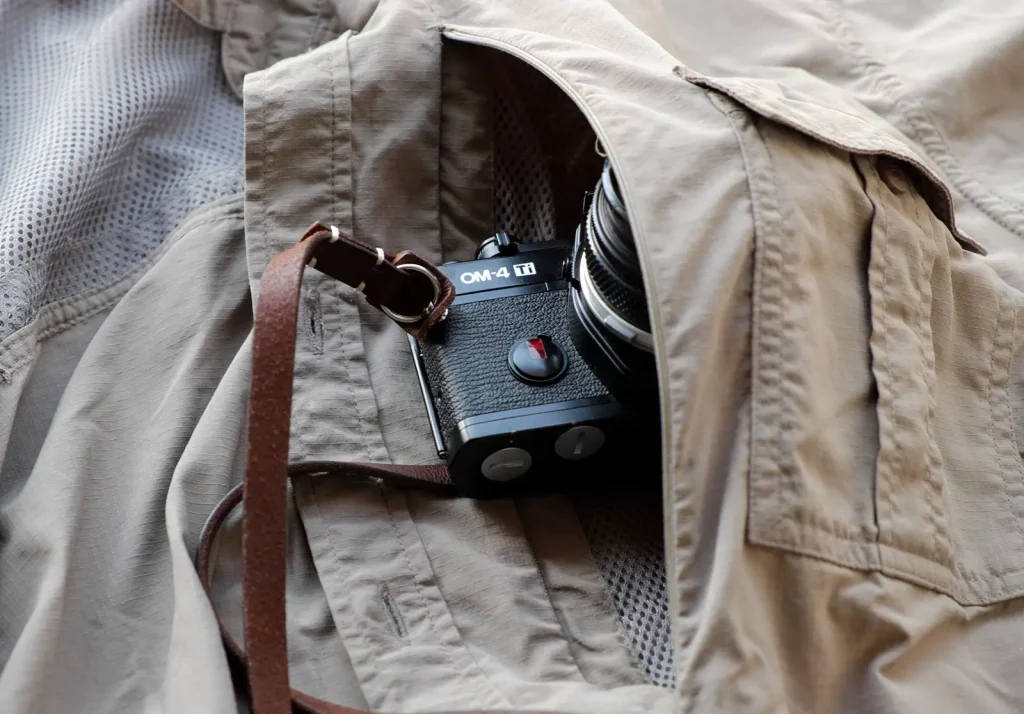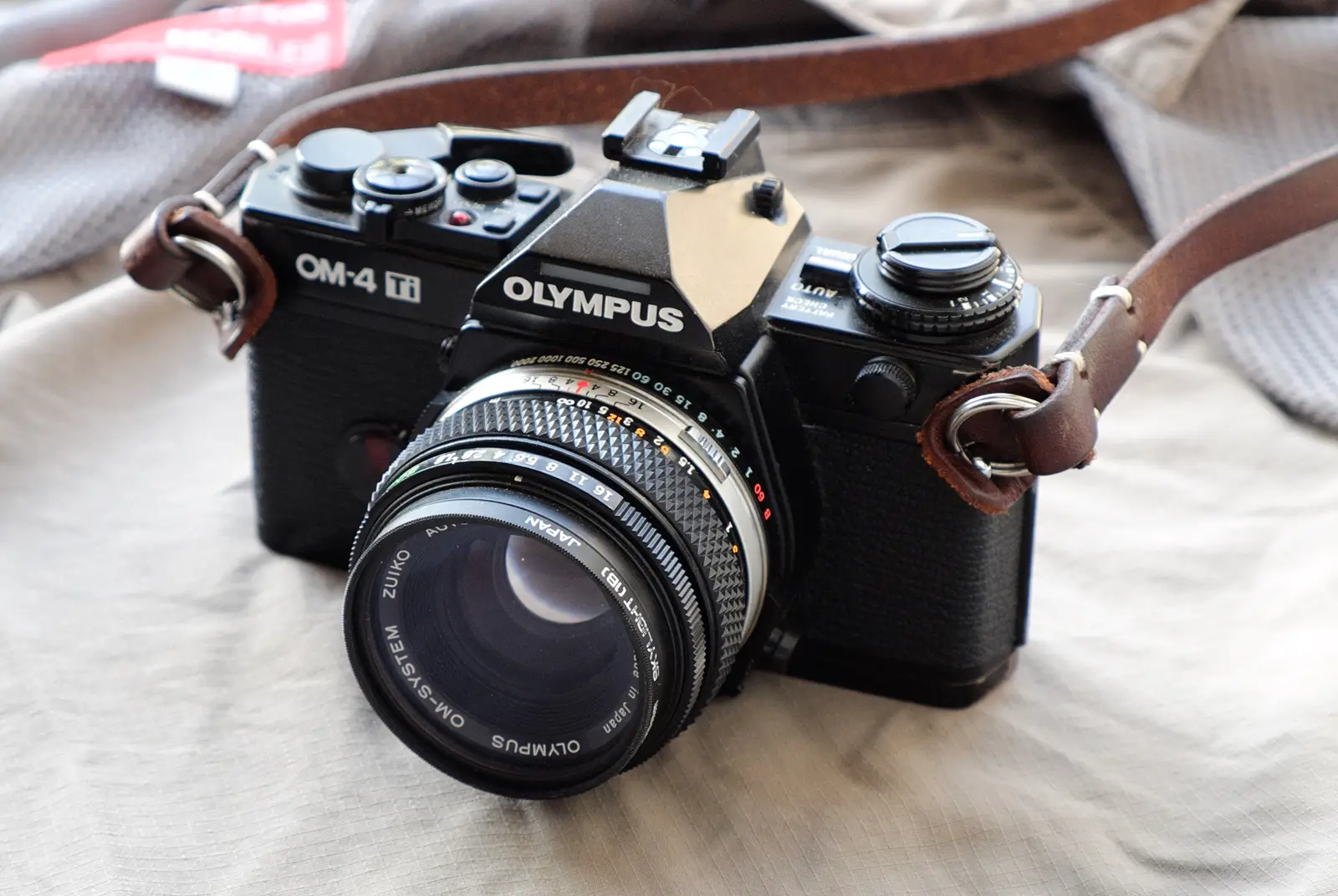Is the Olympus OM4ti camera relevant for 35mmc? I think so. The word “compact” is relative and open to interpretation. There are compact cars and compact vans for example; a ‘compact 35 mm SLR’ is not an unreasonable concept but it basically boils down to size rather than features (a good example would be the Olympus PEN-F from 1963).
A traditional ‘compact camera’ could be defined as:
- Small & light (fits into a shirt pocket)
- Fast & easy to compose and shoot
- Viewfinder/Rangefinder
- Perhaps ruggedized/waterproofed
- Built in flash (or clip-on flash)
- Usually auto film-wind
- Usually 28, 35, 40 mm prime lens (or zoom – generally not so fast)
- Usually with auto-focus
- Usually with DX coding
- Metering range usually +EV only
They are currently available from $5 to $1500 – a massive price band for a single genre of camera (everybody likes them).
Certainly we cannot match an SLR to the full spec’ of a compact camera (with this long list of attributes – size being the priority). However, there are some great SLR options (e.g. Nikon F90) which can cover a wide range of the above features (and then some) so long as the larger size & weight can be accepted by the user.
That could be a non-starter of course (er, size?), but there are some things to bear in mind:
- You could spend 450-1000 GBP (or more) for a high-end compact camera (e.g. Contax or Ricoh). Alternatively you could buy a very nice SLR (for a fraction of the cost) or a high-end rangefinder – with loads of change
- It might be difficult to fix a compact camera if it breaks down (miniaturized moving parts and motors will only last so long: the repair costs could be punitive – assuming it is even possible)
- After a while in “auto” mode the curious photographer will always want more (manual modes may be limited or fiddly with a compact camera – the novelty might not last long)
So why choose an Olympus OM4Ti?
Not in any order:
Size
The Olympus OM4ti is a small and beautiful camera, weighing in at 730 grams with 50 mm f1.8 Zuiko attached. (By comparison it is 110 grams lighter than a Leica M6 with 50 mm Zeiss.) The OM body is narrower & shorter than the Leica but approximately the same width. It will not fit into a conventional shirt pocket but the side pocket of cargo pants is OK (with some bubble wrap). I usually carry the OM inside the air vented pocket of my travel shirt (ideal for quick right hand access):

If you’re ready to accept a larger camera then perhaps a bigger pocket could work for you too? (Yes, for some folks that is a fatuous suggestion but for others, e.g. new to film, it might not be so unreasonable.) This is my shirt, I can recommend it!
Quality
The Olympus OM4ti was the pinnacle of the OM line up – built for long term & serious use. It has top and bottom plates made of titanium (hence the Ti suffix) and it feels “tough” yet precise in the hand (a real pleasure, similar to a Leica M in a way). Note the black paint chips easily – “mint” is rarely true when it comes to the cosmetics of this version of the camera. Overall it is not built to Nikon standards (e.g. FM2) but I have had immense satisfaction with OM’s for a very long time now (happily, my grass is green enough). For an example of toughness there is an OM4Ti torture test here.
Lenses
A wide range of lenses are available and many are highly affordable (from 10.00 GBP upwards). There are ample resources online to guide your decisions, e.g. this one on Zone-10
The 28 mm f2.8 is the best OM lens I have (from 50 mm f1.8, 55 mm f1.2, 85 mm f2, 135 mm f2.8, 200 mm f4) – the negatives really jump out at you, like I get with the 35 mm Summicron on the M6. The 28 mm is not supposed to be a stellar lens (according to reviews) but that’s what I see with my own eyes (wonderful).
Side note: Although lens performance is very important, there seems to be an unhealthy obsession ($) with the technicalities of photography these days (e.g. using ‘fast glass’ and ‘bokeh’) – far more important is what makes up a great photo: subject, message, composition and lighting etc. (Not the smallest f-stop.)
OM System
As important as the camera itself. Olympus has a great pedigree and broad options for expansion if you’re inclined to go ‘non-compact’ down the line.
Metering
If there is ONE reason to buy the Olympus OM4ti it’s for the metering alone. Automatic Centre Weighted metering from -5EV to +19EV @ 100 ISO;f1.4 lens. In low light the automatic exposure extends to 4 minutes (-5EV being moonlight). The spot metering is available in auto or manual mode. The f-stop range (max and min, in view) can be used to adjust the exposure in tune with the characteristic (contrast) curve of the film in use (if you have time and inclination to ponder the shot). It is a great system for experimentation and learning: it helps explain by how much you can adjust the exposure for the required effect.
Side note: My beloved OM1 conked out a while ago but I will probably not fix it – why? Because once you get used to the OM4 metering there is no going back – it changes the way you shoot for the better (more contemplation and better results). If I have two bodies and one canister of film the OM1 will not get a look-in (why waste the opportunity?).
Value
I picked up an Olympus OM4Ti (8/10 condition) for 196.50 GBP off ebay. I also bought a 50 mm Zuiko f1.8 (10/10 condition) for 27.50 GBP. My all-in cost was 224.00 GBP plus shipping (purchased inside the UK). That is a great deal by any standard – patience is needed of course – you could pay a lot more.
In summary
The Olympus OM4Ti can be considered a ‘compact SLR camera’ and is worthy of consideration – Not in any order:
- It’s relatively small and light compared to its ‘compact’ peers (e.g. Nikon F’s and Pentax L’s & M’s)
- It’s a pleasure to own and use. It is a camera (and system) of high spec’ with lots of options down the line
- A wide range of affordable lenses to choose from. There are a some winners (which can be very expensive) but I would urge caution on Zuiko hyperbole: they’re “OK” in my view but in most cases they’re not going to make or break a good photograph
- Stunning metering that provides exposure guidance in a very intuitive way (up to 8 spots averaged). Once you take advantage of this system you will find it very hard using anything else (esp. for zone system aficionados)
- In Auto-mode, with reasonable light and 400 ISO film, you effectively have a point and shoot (using a prime lens with hyperfocal distance set accordingly) – there is no on/off switch
- Full manual control when needed, and no complex menu/button/dial layout like many modern film SLRs (it’s back to basics with a bonus on the metering)
- No motors for film advance or focusing (potential weak spots – long term). Plus, motors mean more power/batteries/weight. (An F90 body weighs more than an OM4Ti with 50 mm attached)
- The OM4Ti is worth repairing if it breaks down (within reason) and there are still specialist shops available
Bottom Line
A 35 mm SLR is most likely no substitute for the high-end compact camera you may be dreaming about (they are indeed very appealing: the size & feel; the sheer simplicity; the convenience and the flash – all add up to a compelling package).
However, if you are unsure about the decision, or are concerned about the cost or durability (such as the real end use & long term satisfaction?) then why not pause for a moment and explore some ‘compact’ 35 mm SLRs? Maybe the trade-offs on size vs. features are negotiable for you? If so, the Olympus OM4Ti might just fit the bill (with a new shirt of course!).
Share this post:










Comments
John Lockwood on Olympus OM4Ti review – a ‘compact’ SLR Camera – by Guy
Comment posted: 12/09/2016
Comment posted: 12/09/2016
Dexter on Olympus OM4Ti review – a ‘compact’ SLR Camera – by Guy
Comment posted: 13/09/2016
Comment posted: 13/09/2016
Ken Hindle-May on Olympus OM4Ti review – a ‘compact’ SLR Camera – by Guy
Comment posted: 13/09/2016
My favourite, though, is my black Pentax MX. This was Pentax's last hurrah for the all-manual SLR at a time when more and more complex electronics were going into cameras and it's a thing of beauty. I also have a (somewhat larger, but still pretty compact) Canon A-1 and while the Canon is perfectly adequate and usable, the Pentax is a joy to shoot. Every mechanism feels smooth and precise, every action satisfyingly solid. Maybe even Leica-like (if anyone wants to send me a Barnack Leica for comparison, that would be great). Although the MX is fully manual in operation, it has a (very reliable) uncoupled light meter as well, giving you the best of both worlds: the convenience of a built-in meter with the comfort of knowing no electrical fault will ever kill the camera. Best of all, and most relevant to this article, is that when paired with the 40mm f/2.8 'pancake' lens, the MX will fit easily in a jacket pocket, making it more compact than some larger 'compacts'. It's a great lens, too. The 50mm f/1.7 is supposed to be the better lens (and it's certainly more versatile) but I haven't observed a noticeable decrease in quality when using the 40mm and I find the smaller size more than outweighs the extra stop.
Comment posted: 13/09/2016
alexandre on Olympus OM4Ti review – a ‘compact’ SLR Camera – by Guy
Comment posted: 13/09/2016
this is great line of cameras for the reason you cited, compact, resilient and most importantly: not enough sought after to drive prices up (except for a few pieces: OM3, 40f2...). good deal can still be had.
i finally found a grail of mine, the OM4ti, after a long search. it was mint and didn't cost me a fortune. bummer is i didn't liked it at all! the release is too soft, too many buttons and the sound of the mirror not as loud as the others (i love that sound!).
i went back to the OM2 and the OM4ti in its box...
but it's a cool piece in a collection :)
jeremy north on Olympus OM4Ti review – a ‘compact’ SLR Camera – by Guy
Comment posted: 14/09/2016
Olympus was a field leader when it came to metering, especially in auto mode. They were the first to meter from light hitting the film itself.
I've not played with the 4Ti but I do have an OM2n which is even prettier, more compact and is incredibly quiet in use. If the 4Ti is as smooth then it's a great camera.
It looks like you got yourself a real bargain there, I've seen them going for twice as much.
Nicholas on Olympus OM4Ti review – a ‘compact’ SLR Camera – by Guy
Comment posted: 14/09/2016
Comment posted: 14/09/2016
BOB RAYSON on Olympus OM4Ti review – a ‘compact’ SLR Camera – by Guy
Comment posted: 15/09/2016
Crusoe on Olympus OM4Ti review – a ‘compact’ SLR Camera – by Guy
Comment posted: 14/01/2017
can somebody tell me where I can find these leather straps? They are looking very decent and well made. I am highly interested to buy 2 of them for my OM-1n and OM-2n.
Thanks!
Crusoe
Comment posted: 14/01/2017
Dustin on Olympus OM4Ti review – a ‘compact’ SLR Camera – by Guy
Comment posted: 02/02/2017
Barry Reid on Olympus OM4Ti review – a ‘compact’ SLR Camera – by Guy
Comment posted: 10/03/2018
The downside, for me at least, is the Zuiko lenses which tend to be a little too contrasty with a slight colour cast in the cyan range.
David Hill on Olympus OM4Ti review – a ‘compact’ SLR Camera – by Guy
Comment posted: 04/08/2018
Fabulous camera, great handling and it has that meter-to-die-for. I used mine hard, through hell and back for 10 years, but my lesson is Keep It Out Of The Weather. These are not weatherproof, and if the electronics go haywire you’re left with 1/60th and nothing else. There are no replacement circuit boards. Learn from my despair.
A fast motor drive (5fps) is available but by today the NiCd cells have mostly gone kaput and will need restoration; the slower “Winder” drives are inexpensive and reliable and use AA cells.
I still dream of getting a OM-3T ... All-mechanical, with the 4Ti meter. But oh dear god they’re expensive...
Jordan Wistle on Olympus OM4Ti review – a ‘compact’ SLR Camera – by Guy
Comment posted: 15/03/2021
Yashicamat 124G – VTScoot on Olympus OM4Ti review – a ‘compact’ SLR Camera – by Guy
Comment posted: 07/01/2022
Further adventures with Adox Color Mission - Kosmo Foto on Olympus OM4Ti review – a ‘compact’ SLR Camera – by Guy
Comment posted: 19/06/2022
Jeffrey on Olympus OM4Ti review – a ‘compact’ SLR Camera – by Guy
Comment posted: 16/08/2023
Comment posted: 16/08/2023
Peter H on Olympus OM4Ti review – a ‘compact’ SLR Camera – by Guy
Comment posted: 23/08/2024
But like all great works of art, there are flaws. They are pretty delicate things, like a Ferrari clutch... You can't treat them rough like you can with the old Nikons. The motor winders (all I could afford) died frequently and the electric circuit boards on the 4Ti don't last too long either. Shame on Olympus for not making the circuit boards any longer, thereby killing the system for professional users and many amateurs too.
Their battery economy is amazing too. Such a contrast to having to turn modern cameras off every time you finish using them, and recharging constantly. A couple of tiny batteries and a spare set in the bag would last for months and months of constant use. They really make a farce of kids these days telling us oldies off for wasting resources back in the day. Kids today use more electricity to make photos in one day than we did in a year, I reckon. You could go travelling for a month and shoot all day long with a handful of spare batteries just in case. Now we have to take chargers and spare heavy batteries.
Thanks for the article, Guy.